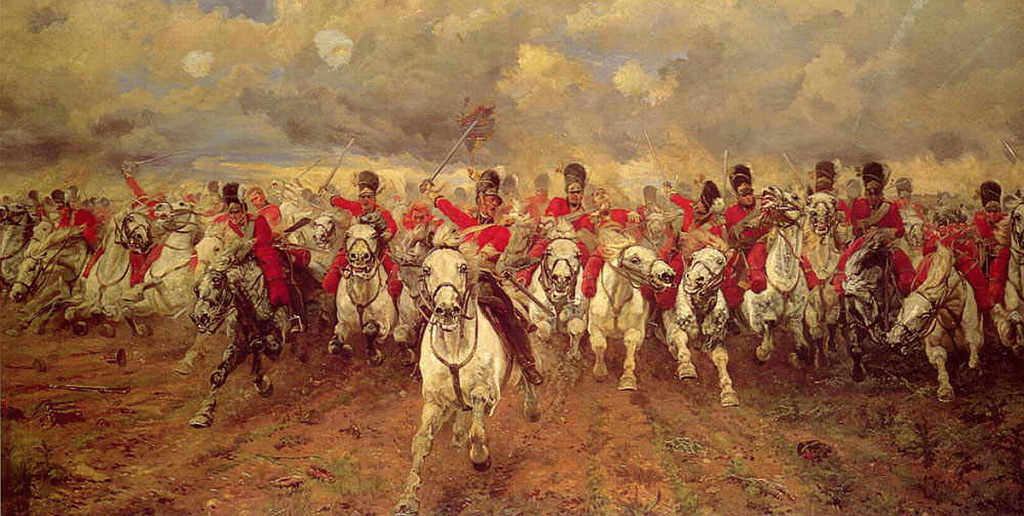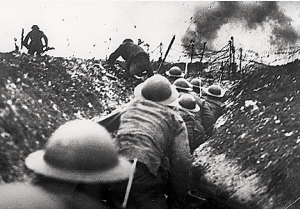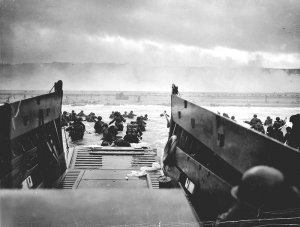Waterloo, the Somme and Omaha Beach
by Francis P. Sempa
The nature and outcome of wars can produce conditions, both psychological and geopolitical, that affect statesmen and strategists in their long-term approach to national security. This is rarely apparent immediately after the end of war when leaders and policymakers are coping with a myriad of problems and issues created by the war, instead of focusing on future grand strategy based on new geopolitical realities. This is all the more reason for strategic thinkers to begin focusing on the postwar world prior to the end of a war. While strategists cannot know the outcome of a war and the new geopolitical realities created by the war prior to its end, they can nevertheless attempt to glimpse the future in the event of victory.
Not every war produces significant global geopolitical change. Wars that do produce such change are frequently the culmination of lengthy conflicts among great powers. In such wars, there are certain battles that foreshadow the resulting geopolitical conditions to which statesmen and strategists should adapt their policies. The three battles discussed below were such battles in such wars. In the aftermath of two of the wars—the Napoleonic Wars and the Second World War—strategy was successfully transformed to deal with new realities; in the aftermath of the First World War, it was not.
Waterloo
Waterloo is in relative terms one of the smallest battlefields in the history of global warfare. The whole battlefield from the gentle slopes of Mont St Jean to Napoleon’s headquarters at Le Caillou is less than six square miles. On June 18, 1815, more than 170,000 soldiers fought there for nine hours to determine the fate of Europe for the next century. The battle, as the victorious Duke of Wellington later remarked, was “the most desperate business I was ever in… “1

The battle began around 11:30am when French forces attacked Wellington’s fortified farmhouse and buildings at Hougoumont. Although planned as a diversionary attack, the fighting at Hougoumont continued on and off throughout the battle, steadily draining French troops. British troops situated behind the sturdy rock walls surrounding Hougoumont, portions of which still stand today, defied repeated French attacks. Years later Wellington wrote that, “The success of the battle turned upon closing the gates of Hougoumont.”2
Two hours into the battle, after directing an artillery barrage from eighty-four French guns on the allied lines, Napoleon sent Comte d’Erlon’s infantry force, some 16,000 troops, in columns to attack the center of Wellington’s line. At a critical moment as French forces ascended the ridge, Wellington’s line held until Lord Uxbridge’s heavy cavalry brigades charged the French troops and sent them reeling back down the slope. Carried away by their success, the British cavalry brigades imprudently plunged into French lines where they were counterattacked by French cuirassiers and suffered forty percent casualties.
Napoleon ordered Marshal Ney to take a second allied fortified position on the field, La Haie Sainte. Ney’s initial cavalry attacks were repulsed and at about 4pm he launched a major cavalry attack at the center of Wellington’s line, thrusting between Hougoumont on the left and La Haie Sainte on the right. More than 7,000 French mounted troops pounded their way to the crest of the ridge along an 800-yard front where they were met by Wellington’s infantry formed into squares. The infantry squares buckled but did not break despite repeated charges by French cavalry. Casualties on both sides were appalling.
At around 6pm, Napoleon ordered Ney once again to attack La Haie Sainte which fell to the French after heavy fighting. The stage was now set for what historian David Chandler has called “one of the most celebrated engagements of military history.”3 French infantry, including the famed Imperial Guard, moved inexorably toward the crest of Mont St Jean. Waiting for them, lying along the reverse slope of the ridge, were British and allied infantry who, upon hearing Wellington shout “Now’s your time,” rose up and fired volley after volley into the stunned French ranks.4 Meanwhile, Prussian troops under Field Marshal Gebhard von Blucher attacked the French from the extreme right of the battlefield. The decimated French fell back and were chased down the slope by allied infantry. The Battle of Waterloo was over. Forty-seven thousand men lay dead or wounded. Wellington, reflecting on the carnage of his last battle, is said to have remarked that the only thing worse than a battle won is a battle lost.5
Waterloo was the culminating battle in a 25-year struggle to deny the French hegemony in Europe. That struggle, which included Nelson’s famous victory over a combined French-Spanish fleet at Trafalgar in 1805, was, as J.R. Seeley wrote in his masterful work The Expansion of England (1901)6, part of a lengthier global conflict between Great Britain and France that began during the reign of Louis XIV. Seeley noted that between 1689 and 1815, England waged seven great wars against France (and other powers), including the War of the Spanish Succession, the War of the Austrian Succession, the Seven Years’ War, the American War, and the wars of the French Revolution and Empire. Seeley viewed those conflicts not as separate independent wars, but as part of a larger struggle for supremacy between Britain and France. The strategists of the great powers—Metternich, Castlereagh, Talleyrand, and others— understood this and developed a new global geopolitical structure known as the Concert of Europe which maintained the general peace of Europe for another century until it was smashed on the fields of Flanders and Picardy.
The Somme
The area of France east of the town of Albert and north of the meandering Somme River was in 1916 of little inherent strategic significance, except for the fact that it was located along a line stretching from the Flanders region in Belgium south to the Swiss border where both sides in the First World War had dug into the earth and established trenches from which to fight. On July 1, 1916, after a week-long artillery bombardment of German positions and the explosion of several mines underneath German lines, British and Commonwealth troops emerged from their trenches and moved forward into “no man’s land,” only to be gunned down mercilessly by German machine guns, rifles, and artillery. On that first day of the battle, nearly 20,000 British and Commonwealth soldiers lost their lives and another 40,000 were wounded. In the next five months, British and Commonwealth forces suffered more than 400,000 casualties (the French, more than 200,000), all to gain a few miles of ground. The battle left a physical scar on the land which can still be seen today at places like Newfoundland Memorial Park near Beaumont-Hamel. It left a psychological scar manifested in the dozens of British and Commonwealth military cemeteries that dot the landscape.7

The First World War, what an earlier generation called the Great War, effectively ended the general structure of peace created after Waterloo. The first crack in that structure occurred with the unification of Germany in 1871 which created a huge, growing industrial and military power in the center of Europe. German Chancellor Otto von Bismarck sought to manage Germany’s rise within the Concert of Europe, but after his removal from power in 1890, German ambitions increased on the continent and overseas. Alliances formed. Mobilization and war plans, including the notorious Schlieffen Plan, proceeded apace. Step-by-step, the European powers approached the abyss until the assassination of Austrian Archduke Franz Ferdinand ignited a cataclysm.
There followed five years of slaughter, epitomized by the Battle of the Somme. When it was all over, four empires had fallen; totalitarian revolutionary political parties seized power in Russia and Italy, and gained adherents in Germany, Japan, and China; and a non-European power, the United States, emerged as a key factor in the European and world balance of power.
In the war’s aftermath, however, democratic statesmen, overcome by the horrors of the Somme and similar battles, failed to grasp the new realities created by the war, especially the impact of revolutionary political parties on great power relations. The democracies gradually disarmed and even pretended to outlaw war in the Kellog-Briand Pact. The French army, the largest in Europe, hid behind the fortifications of the Maginot Line, while British elections produced leaders like Stanley Baldwin and Neville Chamberlain. In the 1930s, totalitarian aggression was met by democratic appeasement, and the origins of appeasement can be traced back to the trenches and fields of the Somme. Twenty-eight years after the Battle of the Somme, U.S. military forces stormed ashore at Omaha Beach to liberate the nations of Western Europe, restore a balance of power, and restructure the world’s geopolitics.
Omaha Beach
The crescent-shaped Normandy beach between the French towns of St. Laurent and Vierville was codenamed “Omaha” by Allied war planners in 1944. On the morning of June 6, 1944, infantry regiments of the American 1st and 29th Divisions approached the coastline after a tremendous naval and air bombardment of the bluffs overlooking the beach. But like the preliminary bombardment at the Somme on July 1, 1916, the naval and air pounding at Omaha Beach failed to significantly destroy the German defenses. As a result, the invading American troops were subjected to murderous machine gun and artillery fire as they hit the beach, though they suffered far fewer casualties than the British did on the first day of the Somme.
 Over the next forty days, the American troops that landed at Omaha Beach slugged it out in bitter, treacherous fighting against their German foes in the bocage country of Normandy, where every hundred yards or so open fields were bounded by thick, earthen hedgerows which to this day impair movement and visibility for pedestrians in the French countryside. The Americans and their British and Canadian allies, along with Free French forces, liberated the western portion of the continent of Europe field-by-field, town-by-town. As more and more American forces landed in Normandy and the American contribution to the war effort outpaced Britain’s, it became evident to some that the United States was becoming the geopolitical successor to the British empire. After the war, a talented group of strategists, including George F. Kennan, Dean Acheson, John McCloy, James Forrestal, and Paul Nitze, among others, understood that what started at the Somme was completed at Omaha Beach— the eclipse of Britain by the United States as the “holder” of the European balance of power.
Over the next forty days, the American troops that landed at Omaha Beach slugged it out in bitter, treacherous fighting against their German foes in the bocage country of Normandy, where every hundred yards or so open fields were bounded by thick, earthen hedgerows which to this day impair movement and visibility for pedestrians in the French countryside. The Americans and their British and Canadian allies, along with Free French forces, liberated the western portion of the continent of Europe field-by-field, town-by-town. As more and more American forces landed in Normandy and the American contribution to the war effort outpaced Britain’s, it became evident to some that the United States was becoming the geopolitical successor to the British empire. After the war, a talented group of strategists, including George F. Kennan, Dean Acheson, John McCloy, James Forrestal, and Paul Nitze, among others, understood that what started at the Somme was completed at Omaha Beach— the eclipse of Britain by the United States as the “holder” of the European balance of power.
The Second World War restructured global geopolitics. Europe, which had been the center of world politics for centuries, was now the most important geopolitical prize in a global struggle between the United States and the Soviet Union. America took the place of Great Britain as the leader of a grand coalition opposed to Soviet Russia which succeeded Germany, as Germany had succeeded France, as the would-be global hegemon. Forty-five years after American forces landed on Omaha Beach, the Berlin Wall came down, the Cold War ended, and a new era of geopolitics was born.
It is too early to tell what the structure of this new geopolitical era will be. Many observers believe that the relationship between the United States and the rising powers of Asia, especially China and India, will define this next era of global geopolitics and that America’s grand strategy should be adjusted to that new reality. Statesmen and strategists would be wise to look to history for guidance, and remember Bismarck’s sage advice that leaders do not create the current of events; they can only float with it and steer.![]()
Notes
1 Christopher Hibbert, Wellington: A Personal History (Reading, Mass: Perseus Books, 1997), p. 185.
2 Andrew Roberts, Waterloo June 18, 1815: The Battle for Modern Europe (New York, NY: Harper Collins Publishers, 2005), p. 57.
3 David Chandler, Waterloo: The Hundred Days (Oxford: Osprey Publishing, 1980), p. 161.
4. Ibid. p. 162.
5 Roberts, Waterloo, p. 120
6 Boston: Little, Brown, and Company. 1901.
7 Malcom Brown, The Imperial War Museum Book of the Somme (London: Pan Books,
1996).
American Diplomacy is the Publication of Origin for this work. Permission to republish is freely granted with credit and a link back to American Diplomacy.
 Francis P. Sempa is the author of Geopolitics: From the Cold War to the 21st Century, America’s Global Role: Essays and Reviews on National Security, Geopolitics and War, and Somewhere in France, Somewhere in Germany: A Combat Soldier’s Journey through the Second World War. He is also a contributor to Population Decline and the Remaking of Great Power Politics and The Conduct of American Foreign Policy Debated. He has written on historical and foreign policy topics for Joint Force Quarterly, The National Interest, American Diplomacy, The University Bookman, Strategic Review, Presidential Studies Quarterly, and the Washington Times. He is an Assistant U.S. Attorney for the Middle District of Pennsylvania, and adjunct professor of political science at Wilkes University, and a contributing editor of American Diplomacy.
Francis P. Sempa is the author of Geopolitics: From the Cold War to the 21st Century, America’s Global Role: Essays and Reviews on National Security, Geopolitics and War, and Somewhere in France, Somewhere in Germany: A Combat Soldier’s Journey through the Second World War. He is also a contributor to Population Decline and the Remaking of Great Power Politics and The Conduct of American Foreign Policy Debated. He has written on historical and foreign policy topics for Joint Force Quarterly, The National Interest, American Diplomacy, The University Bookman, Strategic Review, Presidential Studies Quarterly, and the Washington Times. He is an Assistant U.S. Attorney for the Middle District of Pennsylvania, and adjunct professor of political science at Wilkes University, and a contributing editor of American Diplomacy.
